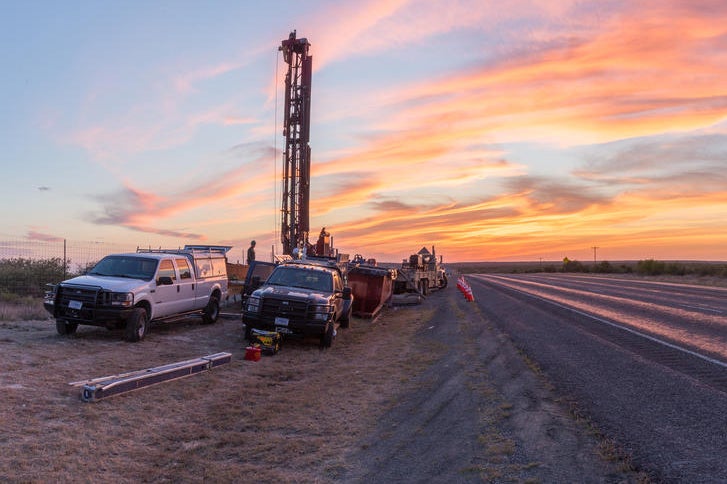Hydraulic fracturing to extract trapped fossil fuels can trigger earthquakes. Most are so small or far from homes and infrastructure that they may go unnoticed; others can rattle windows, sway light fixtures and jolt people from sleep; some have damaged buildings.

A coring and geophysical well-logging operation rises beside U.S. Route 90 in Kinney County, Texas. (Image credit: Stanley T. Paxton, U.S. Geological Survey)
Stanford University geophysicists have simulated and mapped the risk of noticeable shaking and possible building damage from earthquakes caused by hydraulic fracturing at all potential fracking sites across the Eagle Ford shale formation in Texas, which has hosted some of the largest fracking-triggered earthquakes in the United States.
Published April 29 in Science, the results show the most densely populated areas – particularly a narrow section of the Eagle Ford nestled between San Antonio and Houston – face the greatest risk of experiencing shaking strong enough to damage buildings or be felt by people. “We found that risks from nuisance or damage varies greatly across space, depending mostly on population density,” said lead study author Ryan Schultz, a PhD student in geophysics at Stanford.
Social license
Tens of thousands of wells drilled in the vast formation over the past decade helped to fuel the U.S. shale boom and contributed to a dramatic increase in earthquakes in the central and eastern U.S. starting around 2009. Although damaging earthquakes are rare, the authors write, “the perceived risks of hydraulic fracturing have both caused public concern and impeded industry development.”
In sparsely populated areas within the southwestern portion of the Eagle Ford, the researchers found damage is unlikely even if fracking causes earthquakes as large as magnitude 5.0. Allowing such powerful quakes, however, could jeopardize the “social license to operate,” they write. The phrase, which emerged within the mining industry in the 1990s and has since been adopted by climate activists, refers to the unofficial acceptance by local community members and broader civil society that oil, gas and mining operations need to do business without costly conflicts.
“Seismicity is part of the social license for hydraulic fracturing, but far from the only issue,” said study co-author Bill Ellsworth, a geophysics research professor at Stanford’s School of Earth, Energy & Environmental Sciences (Stanford Earth). “Eliminating hydraulic fracturing seismicity altogether wouldn’t change any of the other concerns.”
Among those concerns are health threats from living near oil and gas wells and greenhouse gas emissions from fossil fuel production and use. California’s recent announcement of plans to stop issuing new permits for hydraulic fracturing by 2024, for example, comes as part of an effort to phase out oil extraction and reduce greenhouse gas emissions.
Starting with risk
The researchers say their goal is to make it easier for operators, regulators, local residents and property owners to discuss the risks that are important to them without technical expertise. “The approach we’ve developed provides the risk of nuisance or damage as a shared frame of reference and tools to evaluate it,” said study co-author and geophysics professor Greg Beroza, co-director of the Stanford Center for Induced and Triggered Seismicity (SCITS).
The new risk analysis applies a technique first published last year for considering where people and structures are located as well as forecasts for maximum earthquake magnitude and geological factors that can amplify or dampen tremors as they travel underground. The approach makes it possible to start out with some level of risk – such as a 50 percent chance of 30 households experiencing shaking that feels exciting but not frightening, based on community questionnaires – and calculate the largest earthquake magnitude that would keep risk at or below that level.
The authors propose using this type of analysis as a starting point for managing earthquake risk caused by fracking using a system known as a traffic-light protocol. Adopted in states including Ohio and Oklahoma to manage seismic hazards related to oil, gas and some geothermal energy development, traffic-light protocols give operators a green light to proceed as long as quakes remain relatively small. Larger earthquakes may require an operator to adjust or halt fluid injections, knowing that shaking may continue and even intensify after the pumps shut down.
“If the goal is to treat everyone equally in terms of risk, our analysis shows action should be taken at lower magnitudes for drill sites near the cities in the north of the Eagle Ford than for those in rural areas in the south,” explained Ellsworth, who is also a co-director of SCITS.
According to the researchers, it’s “unfair” to set a uniform threshold for the amount of shaking allowed across a large formation like the Eagle Ford. “Single valued thresholds can allow for thresholds that are too permissive in urban regions or too restrictive in rural regions,” said Beroza, the Wayne Loel Professor at Stanford Earth. “Instead, if you start with a tolerance to risk, you can set thresholds that vary according to changes in the risk.”
Beroza is also co-director of the Southern California Earthquake Center (SCEC).
This research was supported by SCITS.
To read all stories about Stanford science, subscribe to the biweekly Stanford Science Digest.
Media Contacts
Ryan Schultz, School of Earth, Energy & Environmental Sciences: rjs10@stanford.edu
Bill Ellsworth, School of Earth, Energy & Environmental Sciences: wellsworth@stanford.edu
Greg Beroza, School of Earth, Energy & Environmental Sciences: beroza@stanford.edu
Josie Garthwaite, School of Earth, Energy & Environmental Sciences: (650) 497-0947; josieg@stanford.edu